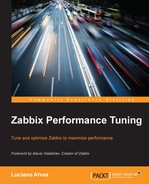Now we need to evaluate two points: the writing speed and reading speed necessary to maintain the environment with adequate performance.
To understand and get to an estimate of the writing ability, we can use a very simple formula: vps * bytes (new values per second * 50). This is considering only the entry of new values of items at the base, and not other Zabbix functions (trends, events, and so on).
For readability, we need to consider the number of users, screens, maps, quantities of items (the generation of the trends depends on the selections in the history of the tables), and so on.
With estimates of reading and writing skills being necessary for our Zabbix environment, we can choose between existing technologies and models in the market drives. There is a report (2014) that contains a comparison with some disk model brands (SATA, SAS, SSD, and so on):

The source for this is http://www.storagenewsletter.com/wp-content/uploads/2015/01/Calypsossd-performance.jpg
After defining the brand model of the disks, we need to decide on whether or not a RAID is needed in our Zabbix environment. The recommendation is to use the RAID concept, as we gain performance and security.
We know that there are some RAID designs to be evaluated that can be chosen for our environment. Each model has its advantages and disadvantages. The most common is RAID10. Some environments make use of RAID5. But what is the best option for RAID anyway? Well, Zabbix SIA guides the use of RAID10 (or RAID1 + 0). The arguments for this are on the explanations of each type. There are many forums and websites talking about the advantages and disadvantages of each type of RAID. The important thing is to understand which of them is the most appropriate for Zabbix. In this case, it is correct to say that RAID5 has better read performance and RAID10 has better write performance. What about your Zabbix environment? Does it have more writings or readings, a lot of users or a few users, a lot of screens or a few screens? Again, the right choice here will depend on your environment and the hardware at hand.
It is necessary to say that RAID5 is dangerous because of the write-hole problem and its long rebuild time. Sometimes, we cannot endure the rebuild time because it is too long. So, RAID10 is a better choice for most environments. Another point to consider is how the RAID will behave when degraded (with one or more disk failures). In RAID5, the degraded performance is not encouraging. However, a disk failure in RAID10 has no impact on performance. What happens during the recovery of RAID? Yes, in this case, the two types are affected by environmental reconstruction tasks.
